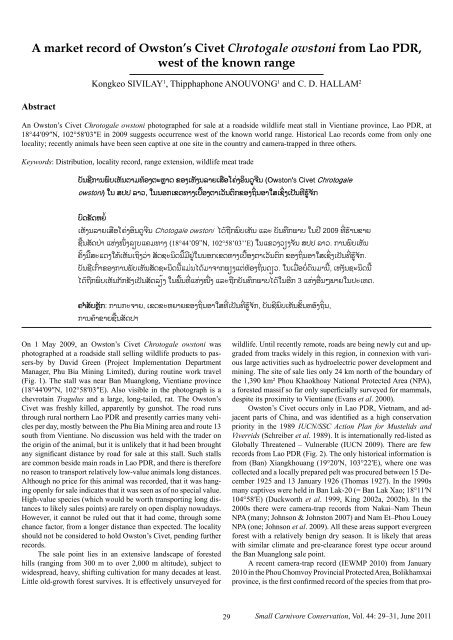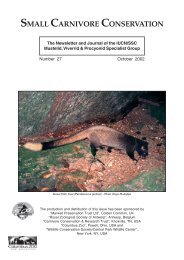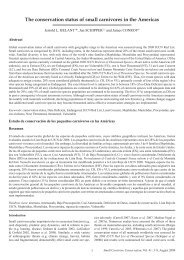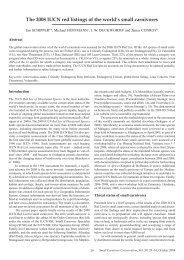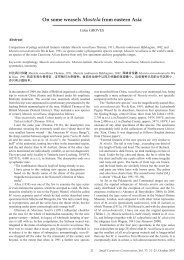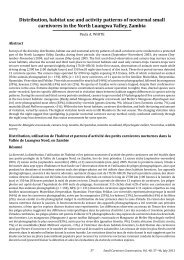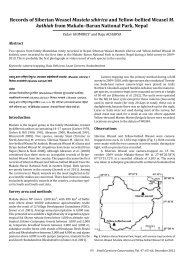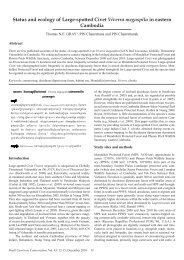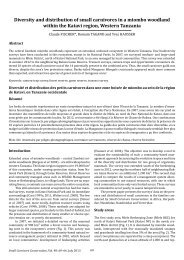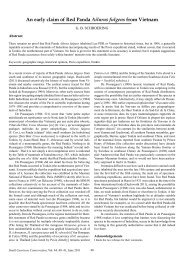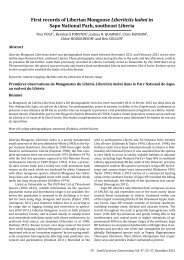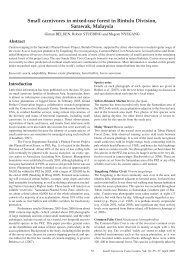A market record of Owston's Civet Chrotogale owstoni from Lao PDR ...
A market record of Owston's Civet Chrotogale owstoni from Lao PDR ...
A market record of Owston's Civet Chrotogale owstoni from Lao PDR ...
- No tags were found...
Create successful ePaper yourself
Turn your PDF publications into a flip-book with our unique Google optimized e-Paper software.
A <strong>market</strong> <strong>record</strong> <strong>of</strong> Owston’s <strong>Civet</strong> <strong>Chrotogale</strong> <strong>owstoni</strong> <strong>from</strong> <strong>Lao</strong> <strong>PDR</strong>,<br />
west <strong>of</strong> the known range<br />
Abstract<br />
Kongkeo SIVILAY 1 , Thipphaphone ANOUVONG 1 and C. D. HALLAM 2<br />
An Owston’s <strong>Civet</strong> <strong>Chrotogale</strong> <strong>owstoni</strong> photographed for sale at a roadside wildlife meat stall in Vientiane province, <strong>Lao</strong> <strong>PDR</strong>, at<br />
18°44′09″N, 102°58′03″E in 2009 suggests occurrence west <strong>of</strong> the known world range. Historical <strong>Lao</strong> <strong>record</strong>s come <strong>from</strong> only one<br />
locality; recently animals have been seen captive at one site in the country and camera-trapped in three others.<br />
Keywords: Distribution, locality <strong>record</strong>, range extension, wildlife meat trade<br />
®ñ−§ó-¡¾−-²ö®-À¹ñ−ª¾´-êɺ¤-ª½¹ù¾© ¢º¤-À¹ñ¤-−쾨-À¦õº-£Ȥºò−©ø¥ó−(<strong>Owston's</strong> <strong>Civet</strong> <strong>Chrotogale</strong><br />
<strong>owstoni</strong>) -Ã− ¦¯¯ 쾸, -Ã−-−º¡À¢©ê¾¤À®œº¤ª¾À¸ñ−ªö¡¢º¤-«…−º¾Ã¦À§…¤-À¯ñ−-êó-»øÉ¥ñ¡<br />
®ö©-¢ñ©-¹¨Ó<br />
À¹ñ¤-−쾨-À¦õº-£Ȥ-ºò−©ø¥ó−Chotogale <strong>owstoni</strong> -Ä©É-«õ¡-²ö®-À¹ñ−Áì½ ®ñ−-êõ¡²¾®- Ã−¯ó 2009 ê†-»É¾−-¢¾¨-<br />
§š−¦ñ©¯È¾ Á¹È¤Î‡¤ì¼®Á£´-꾤 (-18°44’09’’N, 102°58’03’’E)- Ã−-Á¢¸¤-¸¼¤¥ñ−¦¯¯ 쾸. ¡¾−-²ö®-À¹ñ−-<br />
£˜¤-−š-¦½-Á©¤-ùÉ-À¹ñ−-À«ò¤¸È¾- ¦ñ©-§½−ò©-−š-´ó-μøÈ-Ã−-−º¡À¢©-꾤À®œº¤ª¾-À¸ñ−-ªö¡ ¢º¤-«…−º¾Ã¦-À§…¤-À¯ñ−-ê†-»øÉ¥ñ¡.<br />
®ñ−§ó-À¡‰¾-¢º¤-¡¾−-²ñ®-À¹ñ−¦ñ©-§½−ò©-−š-Á´È−-Ä©É´¾-¥¾¡-²¼¤-ÁªÈ-êɺ¤-«…−-©¼¸. -Ã−-À´ô-®Ò-©ö−-´¾-−š, À¹¤ñ−§½−ò©-−š-<br />
Ä©É-«õ¡-²ö®-À¹ñ−-¡ñ¡¢ñ¤À¯ñ−-¦ñ©ì¼û¤ -Ã−-²œ−-ê†-Á¹È¤Îˆ¤ -Áì½-«õ¡-®ñ−êô¡-²¾®Ä©É-Ã−-ºó¡ 3 -Á¹È¤ºˆ−Ų¾¨-Ã−-¯½-Àê©.<br />
£¿¦ñ®Íñ¡: ¡¾−¡½¥¾¨, À¢©¢½¹¨¾¨¢º¤«…−º¾Ã¦ê†À¯ñ−ꆻøÉ¥ñ¡, ®ñ−§ó²ö®À¹ñ−¢˜−êºÉ¤«…−,<br />
¡¾−£É¾¢¾¨§š−¦ñ©¯¾<br />
On 1 May 2009, an Owston’s <strong>Civet</strong> <strong>Chrotogale</strong> <strong>owstoni</strong> was<br />
photographed at a roadside stall selling wildlife products to passers-by<br />
by David Green (Project Implementation Department<br />
Manager, Phu Bia Mining Limited), during routine work travel<br />
(Fig. 1). The stall was near Ban Muanglong, Vientiane province<br />
(18°44′09″N, 102°58′03″E). Also visible in the photograph is a<br />
chevrotain Tragulus and a large, long-tailed, rat. The Owston’s<br />
<strong>Civet</strong> was freshly killed, apparently by gunshot. The road runs<br />
through rural northern <strong>Lao</strong> <strong>PDR</strong> and presently carries many vehicles<br />
per day, mostly between the Phu Bia Mining area and route 13<br />
south <strong>from</strong> Vientiane. No discussion was held with the trader on<br />
the origin <strong>of</strong> the animal, but it is unlikely that it had been brought<br />
any significant distance by road for sale at this stall. Such stalls<br />
are common beside main roads in <strong>Lao</strong> <strong>PDR</strong>, and there is therefore<br />
no reason to transport relatively low-value animals long distances.<br />
Although no price for this animal was <strong>record</strong>ed, that it was hanging<br />
openly for sale indicates that it was seen as <strong>of</strong> no special value.<br />
High-value species (which would be worth transporting long distances<br />
to likely sales points) are rarely on open display nowadays.<br />
However, it cannot be ruled out that it had come, through some<br />
chance factor, <strong>from</strong> a longer distance than expected. The locality<br />
should not be considered to hold Owston’s <strong>Civet</strong>, pending further<br />
<strong>record</strong>s.<br />
The sale point lies in an extensive landscape <strong>of</strong> forested<br />
hills (ranging <strong>from</strong> 300 m to over 2,000 m altitude), subject to<br />
widespread, heavy, shifting cultivation for many decades at least.<br />
Little old-growth forest survives. It is effectively unsurveyed for<br />
wildlife. Until recently remote, roads are being newly cut and upgraded<br />
<strong>from</strong> tracks widely in this region, in connexion with various<br />
large activities such as hydroelectric power development and<br />
mining. The site <strong>of</strong> sale lies only 24 km north <strong>of</strong> the boundary <strong>of</strong><br />
the 1,390 km² Phou Khaokhoay National Protected Area (NPA),<br />
a forested massif so far only superficially surveyed for mammals,<br />
despite its proximity to Vientiane (Evans et al. 2000).<br />
Owston’s <strong>Civet</strong> occurs only in <strong>Lao</strong> <strong>PDR</strong>, Vietnam, and adjacent<br />
parts <strong>of</strong> China, and was identified as a high conservation<br />
priority in the 1989 IUCN/SSC Action Plan for Mustelids and<br />
Viverrids (Schreiber et al. 1989). It is internationally red-listed as<br />
Globally Threatened – Vulnerable (IUCN 2009). There are few<br />
<strong>record</strong>s <strong>from</strong> <strong>Lao</strong> <strong>PDR</strong> (Fig. 2). The only historical information is<br />
<strong>from</strong> (Ban) Xiangkhouang (19°20′N, 103°22′E), where one was<br />
collected and a locally prepared pelt was procured between 15 December<br />
1925 and 13 January 1926 (Thomas 1927). In the 1990s<br />
many captives were held in Ban Lak-20 (= Ban Lak Xao; 18°11′N<br />
104°58′E) (Duckworth et al. 1999, King 2002a, 2002b). In the<br />
2000s there were camera-trap <strong>record</strong>s <strong>from</strong> Nakai–Nam Theun<br />
NPA (many; Johnson & Johnston 2007) and Nam Et–Phou Louey<br />
NPA (one; Johnson et al. 2009). All these areas support evergreen<br />
forest with a relatively benign dry season. It is likely that areas<br />
with similar climate and pre-clearance forest type occur around<br />
the Ban Muanglong sale point.<br />
A recent camera-trap <strong>record</strong> (IEWMP 2010) <strong>from</strong> January<br />
2010 in the Phou Chomvoy Provincial Protected Area, Bolikhamxai<br />
province, is the first confirmed <strong>record</strong> <strong>of</strong> the species <strong>from</strong> that pro-<br />
29 Small Carnivore Conservation, Vol. 44: 29–31, June 2011
Sivilay et al.<br />
Fig. 1. Freshly killed Owston’s <strong>Civet</strong> <strong>Chrotogale</strong> <strong>owstoni</strong> for<br />
sale at a roadside stall, Ban Muanglong, <strong>Lao</strong> <strong>PDR</strong>, 1 May 2009<br />
(Photo: David Green / Phou Bia Mining Limited).<br />
tected area, which also lacks a harsh dry season. The photograph<br />
was taken at 18°29′20″N, 105°05′12″E at an altitude <strong>of</strong> approximately<br />
1,100 m a.s.l. on the northern border <strong>of</strong> the protected area.<br />
The point is around 1.3 km <strong>from</strong> a heavily degraded road that is<br />
accessible by hand-tractor but not pick-up; it is around 7.5 km<br />
<strong>from</strong> the nearest village and around 2.5 km <strong>from</strong> the Vietnam border.<br />
Overall, the species’s distribution and status in <strong>Lao</strong> <strong>PDR</strong> remains<br />
poorly understood, because methods suitable to locate it,<br />
spotlighting and camera-trapping, have been used to sufficient intensity<br />
in few places in the northern highlands or in the Annamites,<br />
the mountains forming much <strong>of</strong> the boundary between <strong>Lao</strong> <strong>PDR</strong><br />
and Vietnam. Extensive spotlighting in the southern two-thirds<br />
<strong>of</strong> the country in the 1990s failed to locate it (Duckworth 1997),<br />
suggesting that it is not common in, and may be absent <strong>from</strong>, the<br />
Mekong lowlands and adjacent foothills, where the dry season is<br />
generally harsher than in the Annamites and northern highlands.<br />
Because <strong>of</strong> the species’s perilous global conservation status,<br />
investigation as to whether it does occur around the Ban<br />
Muanglong sale point is urgently needed. Assuming that it does<br />
so, surveys are warranted to understand its status in the generally<br />
rugged landscape not under protected area designation <strong>from</strong><br />
Phou Khaokhoay NPA north to Nam Et–Phou Louey NPA and<br />
southeast to Nakai–Nam Theun NPA, given the number <strong>of</strong> large<br />
landscape-scale projects planned or underway. Even clarification<br />
<strong>of</strong> whether Owston’s <strong>Civet</strong> occurs in Phou Khaokhoay National<br />
Fig. 2. <strong>Lao</strong> <strong>PDR</strong>, showing sites and protected areas mentioned<br />
in the text. Owston’s <strong>Civet</strong> <strong>record</strong>s come <strong>from</strong> all except Phou<br />
Khaokhoay NPA.<br />
Protected Area is important, because the area is heavily hunted<br />
(Evans et al. 2000). The habitat use <strong>of</strong> the species and its tolerance<br />
<strong>of</strong> encroachment and hunting are too poorly understood to predict<br />
responsibly its status in this part <strong>of</strong> <strong>Lao</strong> <strong>PDR</strong>.<br />
Acknowledgements<br />
Many thanks to David Green and Jeff Millgate <strong>of</strong> PBM, and to Souksavath<br />
Chantangeun and Akchousanh Rasphone for assistance with the map<br />
and abstract.<br />
References<br />
Duckworth, J. W. 1997. Small carnivores in <strong>Lao</strong>s: a status review with<br />
notes on ecology, behaviour and conservation. Small Carnivore<br />
Conservation 16: 1–21.<br />
Duckworth, J. W., Salter, R. E. & Khounboline, K. (compilers) 1999.<br />
Wildlife in <strong>Lao</strong> <strong>PDR</strong>: 1999 status report. IUCN/WCS/CPAWM, Vientiane,<br />
<strong>Lao</strong> <strong>PDR</strong>.<br />
Evans, T. D., Duckworth, J. W. & Timmins, R. J. 2000. Field observations<br />
<strong>of</strong> larger mammals in <strong>Lao</strong>s, 1994–1995. Mammalia 64: 55–100.<br />
IEWMP [= Integrated Ecosystem and Wildlife Management Project] 2010.<br />
Trip report on camera trapping <strong>from</strong> Phou Chom Voy Provincial Protected<br />
Area. Wildlife Conservation Society / Provincial Agriculture<br />
and Forestry Office <strong>of</strong> Bolikhamxai province, Vientiane, <strong>Lao</strong> <strong>PDR</strong>.<br />
IUCN 2009. 2009 IUCN Red List <strong>of</strong> Threatened Species. . Downloaded on 30 November 2009.<br />
Small Carnivore Conservation, Vol. 44, June 2011<br />
30
Western <strong>record</strong> <strong>of</strong> Owston’s <strong>Civet</strong><br />
Johnson, A. & Johnston, J. 2007. Biodiversity monitoring and enforcement<br />
project in the Nam Theun 2 watershed. Final report V1.1. November<br />
2007. Wildlife Conservation Society, Vientiane.<br />
Johnson, A., Vongkhamheng, C. & Saithongdam, T. 2009. The diversity,<br />
status and conservation <strong>of</strong> small carnivores in a montane tropical<br />
forest in northern <strong>Lao</strong>s. Oryx 43: 626–633.<br />
King, L. 2002a. Morphological data and husbandry notes for Owston’s<br />
Palm <strong>Civet</strong>s and Large Indian <strong>Civet</strong>s. Small Carnivore Conservation<br />
26: 20 (including corrigenda at Small Carnivore Conservation<br />
27: 16).<br />
King, L. 2002b. Physiological responses <strong>of</strong> Owston’s Palm <strong>Civet</strong>s and<br />
Large Indian <strong>Civet</strong>s to immobilization with a combination <strong>of</strong> keta-<br />
mine HCl, acepromazine and atropine sulphate. Small Carnivore<br />
Conservation 27: 13–16.<br />
Schreiber, A., Wirth, R., Riffel, M. & Van Rompaey, H. 1989. Weasels,<br />
civets, mongooses, and their relatives. An action plan for the conservation<br />
<strong>of</strong> mustelids and viverrids. IUCN, Gland, Switzerland.<br />
Thomas, O. 1927. The Delacour exploration <strong>of</strong> French Indochina – mammals.<br />
Proceedings <strong>of</strong> the Zoological Society <strong>of</strong> London '1927′: 41–58.<br />
1<br />
Phu Bia Mining Limited, PO Box 5559, Vientiane, <strong>Lao</strong> <strong>PDR</strong>.<br />
Email: Kongkeo.Sivilay@pbm.panaust.com<br />
2<br />
PO BOX 6712, Vientiane, <strong>Lao</strong> <strong>PDR</strong>.<br />
Email: challam@wcs.org<br />
Subscribing to Small Carnivore Conservation<br />
We request all members <strong>of</strong> the Small Carnivore Specialist Group,<br />
all readers, and institutional libraries to subscribe to this bi-annual<br />
journal. The subscription for one year (two issues) is USD 45 or<br />
EURO 33, excluding bank charges. We also welcome subscriptions<br />
for 3 years at the rate <strong>of</strong> USD 125 and EURO 90. Kindly add<br />
USD 10 or EURO 6 or its equivalent for bank charges. Students<br />
<strong>from</strong> developing countries may contact the following directly for<br />
special subscription rates:<br />
Dr. Jerrold L. Belant, Editor-in-Chief, Email: jbelant@cfr<br />
.msstate.edu<br />
Dr. Barney Long, Editor, Email: barneylong@boltblue.com<br />
Dr. Divya Mudappa, Editor, Email: divya@ncf-india.org<br />
Subscription payment can be made through our website via PayPal, bank transfers, or<br />
cheques. For bank transfer details please contact one <strong>of</strong> the persons/email<br />
addresses provided above. Cheques made in favour <strong>of</strong><br />
“Nature Conservation Foundation” should be mailed to:<br />
Dr. Divya Mudappa, Editor, Small Carnivore Conservation,<br />
Nature Conservation Foundation, 3076/5, 4 th Cross, Gokulam<br />
Park, Mysore 570 002, Karnataka, INDIA<br />
When you subscribe, please notify Jerry Belant, Barney Long, and<br />
Divya Mudappa over email with details <strong>of</strong> your cheque or bank<br />
transfer.<br />
31 Small Carnivore Conservation, Vol. 44, June 2011


